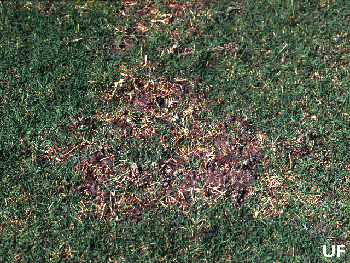Damage to Turf Grasses and their Management
Turf Grasses and Damage by Mole Cricket
Turf grasses commonly grown in the southern United States are:| Bahiagrass | Paspalum notatum Fluegge |
| Bermudagrasses | Cynodon spp. |
| centipedegrass | Eremochloa ophiuroides (Munro) Hack. |
| St. Augustinegrass | Stenotaphrum secundatum (Walt.) Kuntze |
| zoysiagrasses | Zoysia spp. |
|
Mole cricket damage is primarily mechanical: tunnelling through the soil near the surface, severing the roots and uprooting the grass.
Integrated Pest Management
Integrated Pest Management (IPM), is the integration of various control methods based upon a knowledge of the pest(s) to be controlled, especially their population dynamics. The user needs to know what pest species are present, their life cycles, how their numbers (and the damage the cause) vary during the year, at what times during the year they are most vulnerable to control methods, where in the turf they are most abundant, whether they have reached damaging levels or can be ignored now because their numbers are too low to make it worthwhile to spend time, effort, and money controlling them, and the various control options. Furthermore, any control methods used against mole crickets must be integrated with methods that are being used against any other pests (including weeds) and diseases of turf.
Turf Maintenance
Turf maintenance is an integral part of IPM. Encourage a deep, healthy root system which is more tolerant to soil-inhabiting insects such as mole crickets, white grubs and billbugs. Proper mowing, irrigation and fertility practices are especially important to achieve this. Improper mowing and excessive water or fertilization can cause turfgrass to develop a thick, spongy mat of runners and undecomposed clippings above the soil surface. This spongy mat, referred to as thatch, is an excellent habitat for turf insects. Thatch also ties up insecticides, thereby reducing control.
MOWING. Turfgrass can better tolerate damage if it is not cut below a certain height. Do not mow shorter than recommended heights:
| centipedegrass | 1.5-2.0 inches |
| Bahiagrass | 3 inches |
| common Bermudagrass | 0.5-2.0 inches |
| hybrid Bermudagrass | 0.25-0.75 inches |
| St. Augustinegrass | 3 inches in sun, 4 inches in shade |
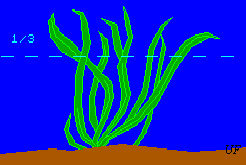 Keep your mower blades sharp. This produces a clean cut which results in less stress and more water retention in the grass. Chances of thatch problems are reduced when not more than 0.25-0.33 percent of leaf tips are cut at each mowing. Cutting at the proper times and height allows your mowing equipment to quickly finish the job, using less gasoline, oil, less wear-and-tear on the equipment, and less in labor costs if you own a lawn maintenance company. Follow correct mowing principles to save money and energy.
Keep your mower blades sharp. This produces a clean cut which results in less stress and more water retention in the grass. Chances of thatch problems are reduced when not more than 0.25-0.33 percent of leaf tips are cut at each mowing. Cutting at the proper times and height allows your mowing equipment to quickly finish the job, using less gasoline, oil, less wear-and-tear on the equipment, and less in labor costs if you own a lawn maintenance company. Follow correct mowing principles to save money and energy.
 IRRIGATION. Don't allow turf to dry out excessively. When irrigation is required, apply 0.75 inch of water to encourage deep root growth. Longer grass blades and deeper irrigation result in deeper roots which allows turf to withstand stress, especially drought conditions, better. Excessive use of water costs money, either as a direct cost or through an increase in taxes. The production of clean water takes energy. You can reduce your energy costs through a wise use of water.
IRRIGATION. Don't allow turf to dry out excessively. When irrigation is required, apply 0.75 inch of water to encourage deep root growth. Longer grass blades and deeper irrigation result in deeper roots which allows turf to withstand stress, especially drought conditions, better. Excessive use of water costs money, either as a direct cost or through an increase in taxes. The production of clean water takes energy. You can reduce your energy costs through a wise use of water.
FERTILIZATION. Fertilize according to soil test for your particular grass type. A soil test to determine nutrients and pH can be obtained through your local county extension office. It is important to maintain optimum levels of potassium and other macro- and micro-nutrient levels.
Rapid succulent growth, resulting from frequent or high applications of water-soluble inorganic nitrogen fertilizers, acts as an attractant to insects. This substantially increases the chances of insect infestation. Incidence of damage from insect pests can be greatly reduced with applications of minimal amounts of slow-release nitrogen fertilizers in combination with other macro- and micro-nutrients.
The wise use of fertilizer can significantly cut your energy costs in mowing and irrigation.
Pest Infestation and Levels and Location
Evidence of the presence of mole crickets in turf is the presence of galleries at the soil surface. Extensive digging by mole crickets to form galleries loosens the soil. Soapy water (1.5 fluid ounces of a liquid dishwashing soap in 2 gallons of water) may be poured on the soil surface (over an area of about 4 square feet, i.e., a square of 2 feet by 2 feet). This will force mole crickets to the surface if the ground is moist and the temperature not so low that the mole crickets are deep in the ground. Identify the mole crickets to species and developmental stage, and count them. If their numbers are more than about one per square foot (an average of 2 to 4 in each area of 4 square feet). then they may warrant control. Their identity and developmental stage determine the types of control that may be used effectively.
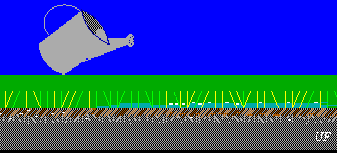
It may well be that mole crickets are not evenly distributed throughout the turf - some areas may have few or none, but some areas may have many. Why not save money by treating only the areas with mole crickets?
When you have surveyed turf (used soapy water to detect mole crickets), it could be worthwhile to record where they were found on a sketch map of the area. Mole crickets tend to occur in the same places year after year. You can use this information next time you see damage, to target the areas where mole crickets are present. You can also use it to measure effectiveness of treatments.
Chemical Pesticides
Recommendations for specific insecticides cannot be given here because these recommendations will vary from state to state. In addition, before using any insecticide there are several items you should check.
- Be sure that the insecticide you use, whether a spray, granule or a bait, is properly labelled for use in turfgrass and that the label clearly lists mole crickets.
- Some insecticides come in several formulations. Be sure that the formulation you use is the correct one.
- Even insecticides properly labelled for the control of mole crickets on turfgrass might have further restrictions on the sites of the applications (golf courses, parks, homes, etc.). Be sure the insecticide you use is legal for the site.
- Insecticides are labelled as to who may legally apply them (licensed operators, homeowners, etc.). Be sure the insecticide you use can be legally applied by yourself or your direct agent.
The best way to find out which insecticides are recommended in your area, and the restrictions that apply to them, is by contacting your local county Cooperative Extension Service office. This branch of your state land grant university will have free brochures and/or inexpensive "for sale" publications on the latest recommendations, and access to university specialists in mole cricket control.
The University of Florida Lawn and Turfgrass Insect Management Suggestions are available on our EDIS page.
SOME BASIC APPLICATION TECHNIQUES
Most mole crickets begin hatching during early June in Florida, depending on the species, and later as you continue north. It is possible to prevent most damage, which occurs later in the year, by the proper timing of insecticide recommendations.
Soap flush is an effective method for surveying mole cricket populations, especially in the late spring and early summer when the crickets are small and tunnelling activity is not readily evident. The section above on Pest Infestations and Levels and Location describes how to do this.
If damage occurred the previous year or if excessive tunnelling was noticed in the turf during the spring months, an insecticide application will probably be required. Mid-June is the optimum time for an application in north and central Florida and probably during late May in south Florida. Before applying a insecticide, inspect the turf for tunnelling activity. If none is noticed, confirm the presence or absence of mole crickets by use of the soap and water technique described above. Insecticides may also be applied in the spring or in July, August and September. However, due to maturity of the crickets at these times of year, control will be reduced.
Mole crickets can be controlled by sprays, granules, or baits. Apply when the overnight temperature is expected to be 60 degrees F or above. Make sure the turf is moist when the treatment is applied. If it has become dry, irrigate the area to be treated by running sprinklers for about an hour. This aids in the penetration of the spray or granules into the soil, or when baits are used, encourages the mole crickets to come to the surface to feed on the bait.
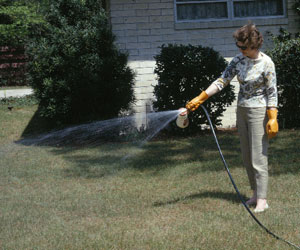 Read and understand all directions on the container label regarding dosage, application information, and precautions. When a spray is used, it is important to apply the insecticide in a large amount of water. For homeowners, the jar attachment to a garden hose is the suggested application device. The type that requires 15 to 20 gallons of water passing through the hose to empty the quart-size jar is recommended. Put the amount of insecticide in the jar as directed on the label for 1000 square feet. Fill the jar the rest of the way with water. Spray the contents over 1000 square feet of turf. To ensure even coverage, spray back and forth across the same area. Pest control companies will use high pressure sprayers or sub-surface injection.
Read and understand all directions on the container label regarding dosage, application information, and precautions. When a spray is used, it is important to apply the insecticide in a large amount of water. For homeowners, the jar attachment to a garden hose is the suggested application device. The type that requires 15 to 20 gallons of water passing through the hose to empty the quart-size jar is recommended. Put the amount of insecticide in the jar as directed on the label for 1000 square feet. Fill the jar the rest of the way with water. Spray the contents over 1000 square feet of turf. To ensure even coverage, spray back and forth across the same area. Pest control companies will use high pressure sprayers or sub-surface injection.
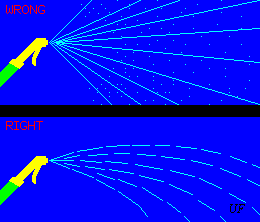
After applying sprays or granules, irrigate for about 2 to 3 hours (or put on about 0.5 inch of water to leach the insecticide into the top 1 to 2 inches of soil).
If a bait is used, apply when it is not likely to rain overnight and preferably late in the afternoon. It is very important to scatter the bait thinly and evenly over the soil surface. A few flakes should fall on every square inch of soil in the treated areas. Baits may be applied by hand. To ensure even coverage, spread back and forth across a measured area, then turn at right angles and spread back and forth across the same area again. If distributing by hand, be sure to wear rubber gloves. Do not irrigate after applying.
PRECAUTIONS
Insecticides are poisons and should be handled as such. Read the manufacturer's label carefully before opening the container and observe all instructions and precautions. Wear rubber gloves and boots when handling and applying insecticides. Do not breathe mists or fumes or spill sprays on the skin. Change clothes and wash all exposed parts of the body immediately after using pesticides. Store pesticides in original labelled containers in a locked area out of reach of children.
The University of Florida offers computer-verified training tutorials on reading pesticide labels and how to handle harmful effects of pesticides with emergency procedures. Information on these tutorials (Core2:Pesticide Labeling (SW-105), and Core6 Harmful Effects and Emergency Response (SW-106) is available on the University of Florida Buggy Software WWW site at http://entomology.ifas.ufl.edu/fasulo/pests/software/ or by calling the UF/IFAS Extension Bookstore at (800) 226-1764.
The insecticide you are using costs you money. Don't waste that money by throwing away containers with insecticide residue still inside. Triple-rinse empty containers and put the rinsing in the spray tank. "Triple-rinsing" consists of placing the recommended amount of rinse solution in the container, closing the container, and agitating the rinse. Drain the solution from the container and place into your spray tank. Allow the container to drain for 30 seconds after normal emptying. Repeat this procedure a total of three times. The container is now considered to be empty of all pesticide materials. Use these suggested amounts of rinsing solution for insecticide containers:
| Container Size | Amount of Rinse Water |
| 1 gallon or less | 1/4 container volume |
| 5 gallons | 1 gallon |
| more than 5 gallons | 1/5 container volume |
You can dispose of empty, triple-rinsed containers (1 gallon or smaller) by wrapping them in newspaper, crushing or puncturing them to prevent reuse, and placing them in a garbage can for disposal in an approved sanitary landfill.
Never use more insecticide than recommended, and never throw out concentrated solutions or non-triple-rinsed containers. This makes you not only environmentally aware, but energy efficient. Polluted areas or water must be cleaned up before they may again be used and this requires energy in many forms. The costs of all these forms of energy are eventually billed to you in taxes. In all your dealings with insecticides the one principle you should never forget is that: We All Live Downstream!
Biological Control
BIOPESTICIDES. Most chemical pesticides (insecticides, herbicides, and fungicides) are capable of harming, to a greater or lesser extent, humans, pets, and wildlife. Biopesticides, in contrast, generally have no effect on humans and vertebrate animals [fish, amphibians (frogs and toads), reptiles (turtles, lizards and snakes), birds, and mammals (including cats and dogs)]. Biopesticides are either (a) living organisms such as insect-killing fungi, bacteria, viruses, protozoans, or nematodes, or (b) dead organisms (such as a few bacteria) whose toxins (the poisons that they produce) are still active.
Some biopesticides that may be used in turf may have a limited effect against non-target organisms of the same group; for example, an insect-killing fungal product applied to the soil to kill mole crickets may do a fairly good job killing mole crickets, and may also kill scarab larvae (white grubs). From the viewpoint of the manufacturer this may be good because there is a dual effect. From the viewpoint of the environmentalist it may be bad, because the organism affects more than one group of insects, so it may affect non-target, harmless insects. To further reduce effects of such biopesticides against non-target insects, they are sometimes incorporated in baits that are attractive to the target pest, so that insects that are not attracted to the bait are not harmed.
Biopesticides that have been marketed for control of pest mole crickets include an insect-killing fungus (Beauveria bassiana) and three insect-killing nematodes (Steinernema carpocapsae, Steinernema riobravis, and Steinernema scapterisci). All three nematodes will kill mole crickets within a few days if adequate numbers of them are brought into contact with the mole crickets. These nematodes are slower-acting than most chemicals. Typically, biopesticides then have no further effect, and this is true of two of the three nematodes. However, Steinernema scapterisci can persist in the soil, even if at lower numbers than when it was first applied, and can thus provide years of benefit in killing mole crickets; it does this by reproducing in the mole crickets that it encounters and kills - its offspring survive in the soil ready to infect more mole crickets - and it will not reproduce in soil insects other than pest mole crickets of the genus Neoscapteriscus. Therefore, of the three nematodes, only Steinernema scapterisci provides a long-term residual effect against pest mole c rickets, and for that reason it is superior; we do not discuss the others in the following text.
Chemical insecticides are typically applied in June-July to kill small mole crickets nymphs. The nematode Steinernema scapterisci, however, is best applied in March-April or September-October against adult mole crickets, because it has very little effect against small nymphs. Furthermore, it is not highly effective against the shortwinged mole cricket which occupies coastal areas of Florida, especially in the southeast. Thus, it is important to known what mole cricket species you are trying to control. Steinernema scapterisci is best used in March-April and September-October against adult southern and tawny mole crickets.
The nematode Steinernema scapterisci is available as a commercial product called NematacTM S. Its disadvantages are, because it is a living organism, that it (a) has a shelf life of only a few months, and (b) is best applied late in the afternoon (or on rainy days) and must be watered well into the soil because it is highly susceptible to ultraviolet radiation from the sun. Its great advantages are (a) that it can do no harm, even if mishandled, to human applicators, and (b) that applications in areas where it was not already present can provide partial control of pest mole crickets indefinitely into the future (for year after year). Companies supplying it will provide application information.
We cannot make any recommendations about use of products containing the insect-killing fungus Beauveria bassiana because we have only laboratory experience with this fungus, and we lack experience in turf. These products may or may not preform as expected (advertised).
CLASSICAL BIOLOGICAL CONTROL. Classical biological control is the importation of specialized natural enemies of pests that arrived from somewhere else. Pest mole crickets (Neoscapteriscus mole crickets - the shortwinged, southern and tawny mole crickets) arrived about 1900 from southern South America. Classical biological control for them involves importation and establishment of their specialized natural enemies from southern South America. This has been partially accomplished by research. Thus, the parasitoid wasp Larra bicolor, the parasitoid fly Ormia depleta, and the entomopathogenic nematode Steinernema scapterisci were researched, imported, researched again, released and distributed in Florida by University of Florida researchers in the 1980s. Predatory larvae of the South American beetle Pheropsophus aequinoctialis have been imported to Florida but not yet released because the necessary research is incomplete, due to lack of funds.
Ideally, classical biological control will solve the entire pest problem by providing area-wide control. However, it has thus far reduced but not yet entirely solved the mole cricket problem. Continued research may do much more to reduce mole cricket populations and the damage they cause, but only if funds become available. Such research is for the benefit of the public - no product is sold and there is no direct means of recovering the costs of research from those who benefit.
MANIPULATIVE BIOLOGICAL CONTROL. Populations of the fly Ormia depleta now occupy 38 Florida counties (from Alachua County to Dade County), and the wasp Larra bicolor is known to exist in Alachua and Clay (and perhaps some other) counties in the north, and in a small part of Broward County in the south. The larvae of the fly and the wasp eat pest mole crickets only, but the adults feed on plant nectars. Populations of the fly are high in some places in southern Florida, but low in others (even when there are lots of mole crickets). This suggests that provision of plants that the adult flies use as nectar sources could build up populations of the fly where their action is needed. Research is in progress to determine what are the plants that the fly uses as nectar sources at various times of year and in various parts of Florida. When the research is complete, it should be possible to provide lists of useful plants that could be used in landscaping. A second list of plants that the wasp uses as nectar sources will also be researched. Such a use of plants to enhance populations of a biological control agent is called manipulative biological control.
AUGMENTATIVE BIOLOGICAL CONTROL. Populations of the mole-cricket-killing nematode Steinernema scapterisci now exist in several Florida counties. In some counties (for example, Alachua) they are widespread, but in others they may be present only in a few places and in small numbers, although in a long enough time they should spread throughout those counties. Applications of the nematode (as a biopesticide, at about 200,000 per square yard) may be made where its effect is wanted in damaged turf, even though a few of the nematodes may already be present in the turf. The objective of augmenting the numbers in the damaged area is to build up the nematode population to reduce mole cricket populations rapidly. This is called augmentative biological control.
In contrast, numbers of the fly Ormia depleta are best enhanced by manipulative biological control as described above. This is because the fly already is present in most of peninsular Florida and its adults are very mobile. It is also because the nematode can be mass-produced as a biopesticide and sold at a reasonable price, whereas the fly cannot be mass-produced inexpensively.
